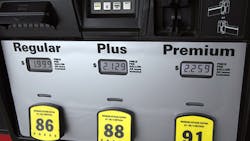Gas prices near my house rose dramatically the last week; we're up to $2.19 a gallon! At the lowest point, a couple of weeks ago, I think I paid $1.87.
I'll admit it: I love these lower gas prices. I remember spending nearly $60 to fill up my tank not that many months ago. I didn't like that at all.
There are a number of reasons for lower prices… I know that OPEC's refusal to cut production, despite a lower demand, has created a glut that contributed to lower prices. I also know that President Obama, in the state of the union address, called the United States "No. 1 in oil and gas." Politicians stop just short of attributing the lower energy prices to U.S. energy production – mostly because they don't want to take the blame when prices rise – but the unspoken message is that increased American energy production is good for everyone.
But is it?
Little is known about the environmental and public health impact of certain natural gas extraction techniques – hydraulic fracturing, for example – that occur near residential areas. An expensive and effective advertising campaign from EnergyFromShale.org titled "Safe for Our Land" highlights the stories of "real" Americans who live off the land. These farmers and ranchers and small business owners have allowed fracking on their land or in their community because they talked to "experts" (no doubt from the energy companies) and decided, "It's safe for our land, our water and our air."
A study published in September 2014 in Environmental Health Perspectives found the opposite to be true: Residents who live near fracking operations experience more health issues than people who do not live near natural gas wells or fracking operations.
"Our study suggests that natural gas drilling may increase the risk of health symptoms in people living near the wells," said the study's senior author Meredith Stowe, associate research scientist at the Yale Occupational and Environmental Medicine Program and lecturer at the Yale School of Public Health.
I live in Ohio, a state that has experienced a significant increase in earthquakes in recent years. The increase coincides with increased fracking in the state. In fact, research published in the January Bulletin of the Seismological Society of America links a series of 77 earthquakes in Ohio to fracking.
On Feb. 17, a train hauling crude oil from North Dakota to Virginia derailed and exploded into flames in West Virginia. The explosion and subsequent leak of crude oil into the Kanawha River involved 109 tankers and two locomotives. The incident prompted an evacuation of nearby towns and impacted local water supplies.
According to the National Transportation Safety Board, rail shipments of crude oil have increased over 400 percent since 2005.
"The large-scale shipment of crude oil by rail simply didn't exist 10 years ago, and our safety regulations need to catch up with this new reality," (NTSB) Chairman Deborah Hersman said in a statement. "While this energy boom is good for business, the people and the environment along rail corridors must be protected from harm."
Lac-Megantic, a town in Quebec, nearly was destroyed in July when a tanker carrying crude oil derailed and exploded, killing 47 residents and destroying the center of town.
I'm not naïve. I understand that energy production is vital to our future. I also am not gullible, and the history of this country reveals that as a nation, we are willing to overlook safety hazards in the name of production. We did it as the railroads were being built; we did it as child laborers toiled in factories and mines at the turn of the century; we did it in meat-packing plants in the early 20th century; we did it during the production of nuclear weapons during WWII; and we're doing it now in manufacturing facilities, mines and oil and gas production.
In my opinion, the end does not justify the means. We cannot overlook the environmental impact or the safety of residents or workers for gas that's $2 a gallon.
About the Author

Sandy Smith
Sandy Smith is the former content director of EHS Today, and is currently the EHSQ content & community lead at Intelex Technologies Inc. She has written about occupational safety and health and environmental issues since 1990.
